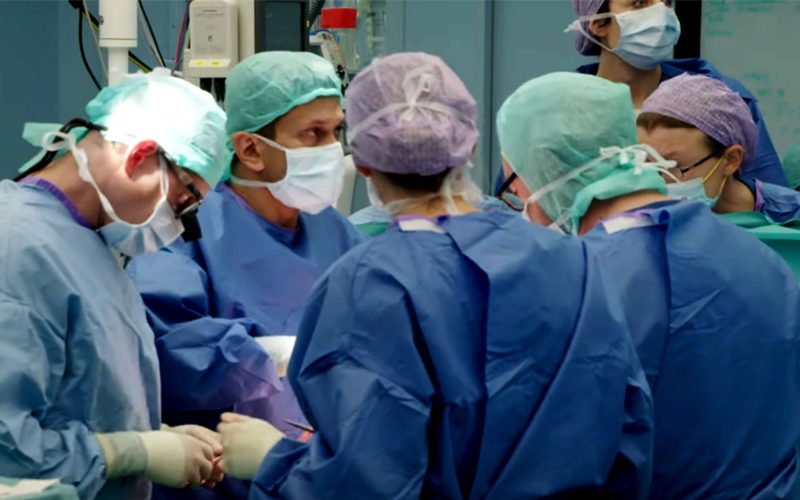Over the past 20 years, UMC Utrecht has developed expertise in guiding and treating adults with congenital heart defects, also known as Adult Congenital Heart Disease (ACHD). The UMC Utrecht distinguishes itself in this field by performing highly complex cardiac catheterizations using unique 3D technology, as well as a high-quality support heart program for patients with end-stage heart failure. UMC Utrecht ACHD cardiologists Heleen van der Zwaan and Michiel Voskuil explain.
A common procedure in adults with a congenital heart defect involves cardiac catheterizations. Michiel: “Catheterization means that we perform an operation through a thin tube that we insert through the groin. For example, for placing stents and new valves in the pulmonary artery and placing stents in a complex narrowing of the aorta, the large body artery. Catheterizations prevent a patient from having to undergo open-heart surgery and are therefore significantly less stressful for a patient. At UMC Utrecht, we perform the most complex catheterizations using innovative 3D technology. The use of this technique is unique in the Netherlands and even in much of the world.”
Michiel further explains: “What makes these procedures so complex is that a patient has often already been operated on several times before this, during which all kinds of changes have been made to the heart. As a result, the construction of the heart is different in each patient and there is sometimes a lot of scar tissue. By using innovative 3D technology, we can 3D map a specific patient’s heart and see exactly what it looks like. We can then better prepare a catheterization. Even during surgery, this technique allows us to see exactly where we need to be by superimposing a 3D image of the heart over the X-ray images. In recent years, together with the pediatric interventional cardiologists at the Wilhelmina Children’s Hospital (WKZ), we have built up expertise in this unique approach to high-complexity catheterizations and can help patients well, with less risk of complications.”
Another important group of patients helped at UMC Utrecht are adults with congenital heart defects who develop heart failure. “This group of patients will only continue to grow in the future,” says Heleen. “Because we can successfully operate on patients in childhood, more than 90% of them reach adulthood. In time, however, some of them develop heart failure.”
Patients with heart failure are treated with a combination of medications. Those with end-stage heart failure can be helped with a donor heart. “However, there is a huge shortage of donors in the Netherlands,” Michiel said. An alternative is implanting a support heart. A support heart is a mechanical pump, which takes over the function of either the left or right ventricle.” Heleen adds, “Patients referred to us from several hospitals are often seen in our center for congenital heart defects by an ACHD cardiologist as well as a heart failure cardiologist. In terms of numbers of patients and specific expertise, UMC Utrecht has the largest support heart program in the Netherlands. On average, about 45 adults receive a support heart at UMC Utrecht each year.”
Some people can live with a support heart for a long time, others will still have to undergo a heart transplant after some time. Also, not every patient qualifies for a support heart. Then the only option is a heart transplant. Michiel: “We have been successfully implanting DCD donor hearts at UMC Utrecht since last year. This allows more people, including people with a congenital heart defect, to receive a donor heart. At the end of last year, the UMC Utrecht was also the first in the Netherlands to implant a complete artificial heart on the recommendation of the support heart manufacturer.
The UMC Utrecht also has extensive surgical expertise regarding Ross surgery in patients in whom the aortic valve is severely leaking or narrowed. Both in young children and young adults. Heleen explains, “During this operation, the patient’s own pulmonary valve is placed in the aortic position, and a donor valve is placed in the pulmonary artery. With this procedure, you avoid placement of a mechanical valve that requires blood thinners, which do not go well with pregnancy, for example. So this makes this surgery relevant, for example, for female patients. One of our team members, Professor Schoof, is one of the world’s leading experts on this Ross technique.”
Both the care of children with a congenital heart defect and the care of adults with a congenital heart defect take place at one location in the UMC Utrecht. This means, for example, that heart operations and catheterizations are performed jointly by teams of both pediatric specialists (surgeon and cardiologist) and adult specialists. Heleen: “Also cardiac catheter treatments for cardiac arrhythmias (electrophysiology), are performed in both children and adults by the same team. With this broad expertise within our team, we strengthen each other and can offer all treatments. This contributes to the high-quality life-course care we provide to patients with congenital heart defects; from before birth to old age.”
